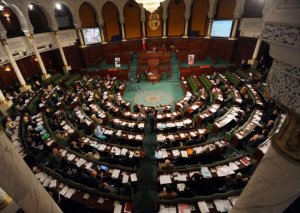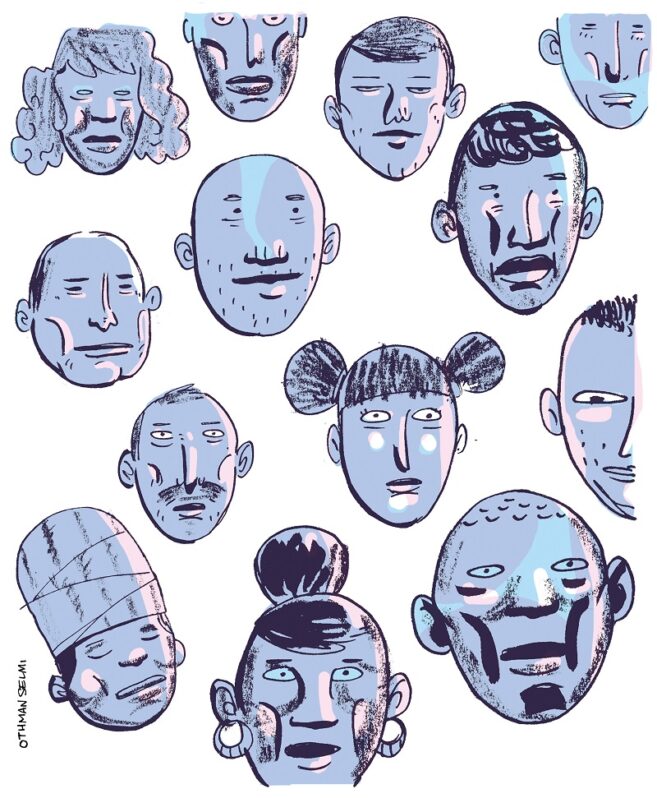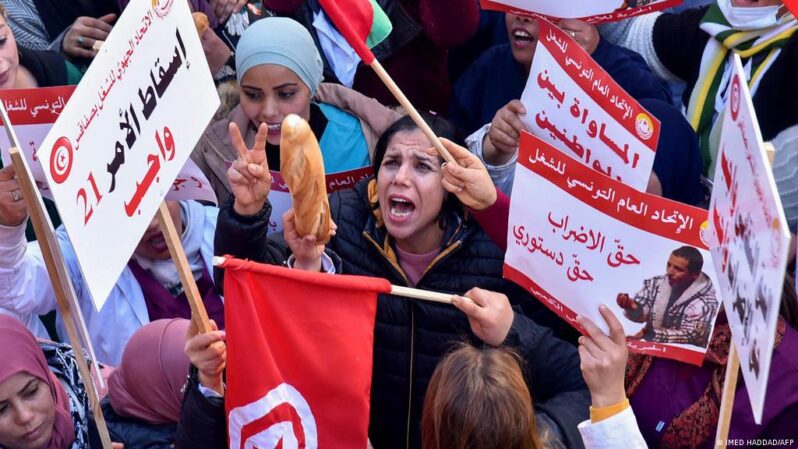Tunisia: The Collective Making of a Constitution

Tunisia’s National Constituent Assembly (NCA) session held on January 26, 2014 did not put an end to disagreements among its members. However, it did represent the culmination of the work done by members. These members were elected by people on October 23, 2011 to draft the provisions of the Constitution of the Tunisian Republic. The draft was ratified during the January session. The ratification of the Constitution has thus pushed quarrels and political conflicts among assembly members from centre stage to the margins.
Before the NCA had begun its work, politicians promised to complete the drafting process in one year. However, drafting the 149 articles of the Constitution took two whole years. The extra time taken undermined public trust in the constituent institution, which was a top demand of the revolution.
Indeed, in the early days of the revolution, the NCA was raised as a slogan by protesters in Kasbah Square as a symbolic reenactment of the experience of drafting the country’s independence constitution. Before its completion, the recently ratified Constitution was the object of criticism by those who argued it would undermine the gains of modernism on the one hand, and those who felt it will do away with the cultural particularities of Tunisian society on the other. Yet, its provisions lay the foundations for rights and liberties in a manner that would reconcile the demands of both camps within its framework.
However, Tunisia’s success at drafting a new constitution -despite its democratic experience being a recent one- is exemplified by the manner in which this Constitution was drafted, including the diversity of those who participated in the drafting process. In fact, the drafting process may well be the most important feature of the Constitution, possibly more so than its content.
On October 23, 2011, the Tunisian constituent process began with the election of NCA members. The choice of electing a distinct constituent authority represented a theoretical commitment to the rules of democracy. It also marked a departure from the notion of leaving the constitutional drafting process to legal experts, politicians and other public figures.
Yet, NCA members chose to give their work a different dimension, further developing the notion of the democratic nature of constituent work. They willingly chose to seek the advice of experts, and invited voters to voice their opinion about the draft Constitution. This allowed civil society to impose amendments to successive draft constitutional texts, after its interest in the drafting process surprised politicians. It also allowed the minority within the NCA to devise new ways to pressure the majority and affect the constitutional drafting process.
Starting from indirect democracy, constituent work eventually turned towards a unique kind of democracy that is difficult to describe in theoretical terms. The streets played a role and experts bore some responsibility in this new kind of democracy, while civil society groups visibly affected its content. National dialogue sponsored by such groups would now determine the fate of contentious provisions in constitutional articles. Held within a framework of political consensus, such a dialogue led to an implicit referendum on the draft Constitution, allowing all participants to amend provisions and review their drafting.
This difficult and novel approach led to developing mechanisms of legislation unique to the Constitution. Such characteristics effectively gave the constitutional text an exalted standing, not only in terms of the hierarchy of laws, but also in view of everyone’s participation in its development.
Discussing the Constitution and Consulting Experts as a Constitutive Choice
The National Constituent Assembly was left with the responsibility of drafting the constitution starting -as its president Mustapha Ben Jafar put it- from a blank slate. Yet, when the NCA first assumed its functions, political parties, civil society groups and constitutional law experts presented it with numerous draft constitutions. This drove the assembly to put the preliminary draft up for discussion, promising to examine all suggestions.
Discussing the Draft Constitution as a Choice of Principle
On December 14, 2012, the NCA began to formulate its second rough draft of the Constitution. The latter is effectively considered the first clear formulation of the constitutional text. Indeed, the first rough draft did not resolve any of the disputed issues, but merely presented the various opinions about them.
As part of a joint project with the United Nations Development Programme (UNDP), the NCA also took the initiative of presenting the draft to the general public. This allowed ordinary citizens in different parts of Tunisia and in the countries of emigration to contribute with their comments. Dubbed the “national dialogue program over constitutional provisions”, this process allowed more than five thousand Tunisians to take part in a total of 26 meetings held in the country and 18 abroad.
The general discussions of the draft by NCA members revealed the extent of societal interest in the constitutional text. Meanwhile, the suggestions and remarks the NCA received exposed inadequate formulations and contradictions in the text. This forced assembly members to seek the assistance of legal experts.
The Role of Legal Experts in Drafting Constitutional Articles
Ratified on January 20, 2012, the first draft of NCA bylaws charged one of its main organs, the Joint Commission for Coordination and Drafting, with the task of “coordinating among constituent commissions and reformulating constitutional texts in line with general session remarks”. However, the general discussion of the second rough draft and the remarks of legal experts and academics revealed formulation flaws and contradictions in its provisions. This forced the NCA to revise its bylaws on March 15, 2013, and integrate general discussion suggestions and legal expert opinions into the work of the assembly. The new bylaws required the Joint Commission for Coordination and Drafting to seek the advice of experts in its work. Similarly, constituent commissions were now expected to look into the suggestions of the Tunisian streets.
When the drafting began, a wide array of specialists in the legal field tried to take over the task of writing the Constitution, arguing that this was a technical process. The NCA resisted this and held on to the fact that the people entrusted it alone with this responsibility. It argued that the Constitution should express national choices and that the role of legal experts should be restricted to studying it and analyzing its provisions.
The outcome of this process was recognizing the people’s right to write their own Constitution, through their elected representatives and without tutelage of any kind. Yet, when it came to clarifying legal concepts and terms, refining formulations and uncovering internal contradictions in the text, the importance of the role played by legal expertise was also acknowledged.
Agreement between legal experts and the people’s representatives certainly affected the development of the constitutional text in terms of form. The assembly’s spontaneous attempt to open up to society had an impact as well. Yet, between the second rough draft and the formal draft presented on June 1, 2013, the development of the text was not just the result of the NCAs work. Indeed, it was even more so the result of political and legal conflict that exceeded conventional notions.
Conflicting Visions Lay the Groundwork for Consensus
As outlined by election results, the political structure of the NCA prevented any parliamentary bloc from securing the quorum needed to ratify the Constitution on its own: a majority of two-thirds is required. This quickly led to divisions among NCA members in their work on the draft Constitution.
On the one hand, an active minority described as democratic, called for the strengthening of human rights in Tunisia and for laying the foundations for a secular state. On the other hand, a pro-Islamist majority, while publicly committed to establishing a democratic system, called for giving special importance to religious and cultural elements in constitutional provisions. The Tunisian streets witnessed similar political division over the Constitution, although the interference of radical ideas (salafist or modernist) perhaps made it seem more severe.
Despite having nearly turned into a conflict on a number of occasions, such disagreements eventually led to finding mechanisms to achieve consensus between the two sides. In the end, agreements over the Constitution were reached both within the NCA and outside of it.
Consensus as a Working Method Within the Assembly
Constituent commissions are charged with writing rough drafts of the articles of the constitution according to their own area of expertise. When forming such commissions, NCA members also took into account political differences and proportional representation within the assembly. This allowed all parliamentary blocs to be adequately represented.
The various commissions worked to achieve maximum consensus among their members over draft constitutional provisions. Contentious articles were left to be resolved later, after having all been examined. Nevertheless, disagreements over some important articles connected to freedoms or to social gains and cultural particularities, led to conflict erupting among representatives and obstructed their work.
As a result of such conflict, assembly members agreed to create a Consensus Commission working within the NCA, charged with looking into all contentious provisions. This new commission successfully amended a number of such provisions, allowing them to be accepted by all. The parliamentary minority was therefore able to impose a new balance of power within the assembly. This allowed it to achieve full partnership in drafting the Constitution, while driving the latter’s provisions to adhere to universal human rights values. Meanwhile, the majority was able to impose its own vision of an objective relationship between local cultural values and the values of democracy.
Regarding the system of government, the conflict in the end resulted in laying the foundations for a unique political system. Moreover, while some consider the latter to be a modified presidential system, others view it as a modified parliamentary system. At the end of the day, such a system ensures balance between the two heads of the executive.
The parliamentary minority also managed to successfully defend the independence of the judiciary, thwarting the majority’s attempt to impose executive interference in its work. The conflict thus laid the groundwork for cultural gains that visibly affected constitutional provisions in a positive way, as all parties agree.
Yet, conflict within the assembly did not shape the Constitution alone. Indeed, conflict outside the NCA also enriched it and ensured its successful ratification, especially during the final stages.
Consensus Outside the Assembly Ensures the Success of the Constitution
The assassination of assembly member Mohamed Brahmi on July 25, 2013 led a number of opposition NCA members to boycott the work of the NCA and demand its dissolution. Their view was that it would fail at its task and turn into an instrument of those in power. The Tunisian public became politically divided. Some demanded ending the experience of transitional democratic institutions and looking for alternatives, while others defended electoral legitimacy and clung to state institutions. It all seemed to suggest that Tunisia would soon slip into a quagmire of internal quarrels reminiscent of Egypt’s experience.
Yet, by announcing their national dialogue initiative, civil society organizations, the Tunisian General Labor Union (the country’s largest labor union), the Tunisian Union for Commerce, Industry and Handicrafts (the organization representing traditional forces), the National Council of the Tunisian Bar Association and the Tunisian Human Rights League effectively defused the crisis and allowed the constituent process to resume.
Their initiative made the commitment to preserve the NCA and help ensure the success of its work, providing support mechanisms in the form of consensus-seeking national dialogue. Such national dialogue sessions were able to bring opposing political parties together, providing them with the opportunity to achieve consensus over provisions they had failed to agree upon inside the assembly. The consensus reached was the result and the product of the work done. In fact, a number of constitutional provisions were eventually drafted outside the assembly, only to then gain the approval of its members.
In addition to the national dialogue and consensus reached, judges, human rights advocates and journalists also played a role in amending constitutional provisions. This was the result of protest movements organized by unions and syndicates, which confronted certain provisions. Such provisions could have turned the Constitution into a mere statement of principles, without guarantees of implementation.
In conclusion, it appears that dialogue and consensus after conflict were what truly shaped the articles of the Constitution. Although attributed to the NCA, this Constitution is in reality the outcome of a social movement that defended certain visions and achieved consensus over them. That is what truly distinguishes the Constitution of the Second Republic.
This article is an edited translation from Arabic.



